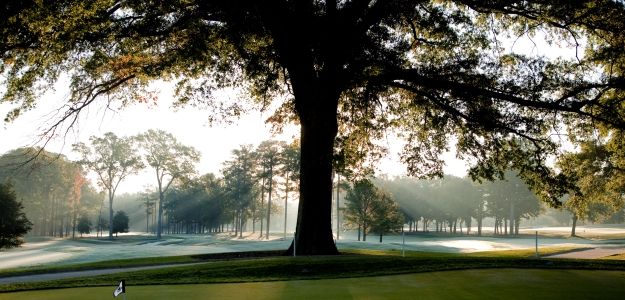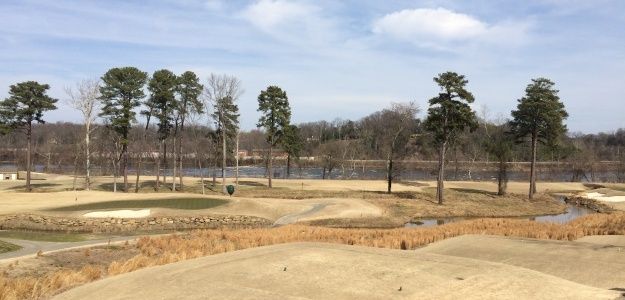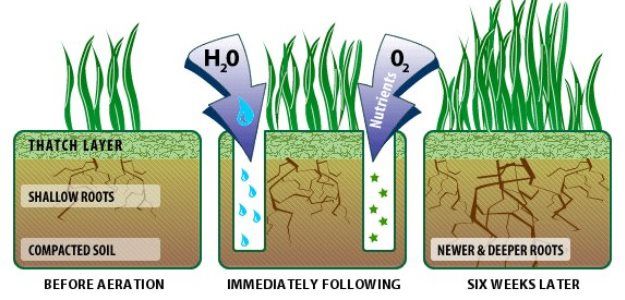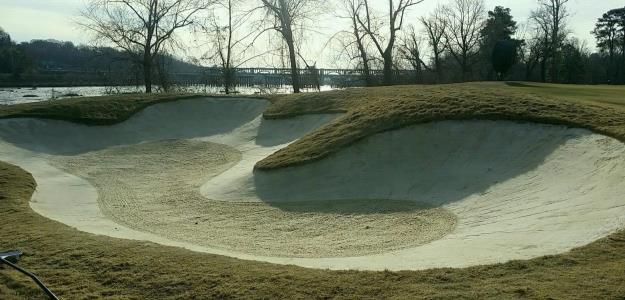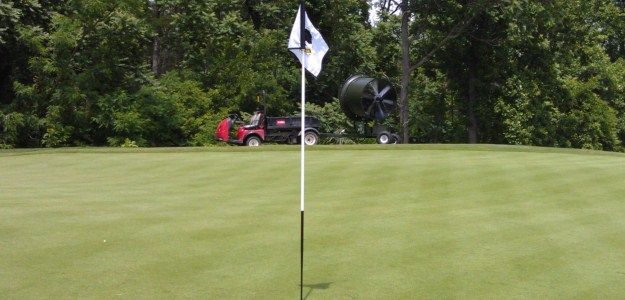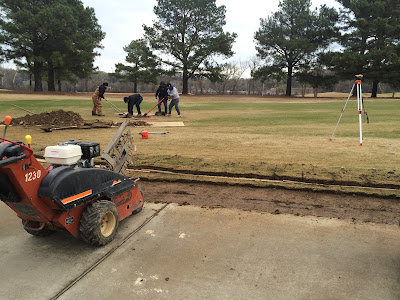Every winter season, our team prepares a project list based on plant health needs and recommendations from the Green Committee. Normal projects include tree work, drainage installation, refurbishing course amenities, and fan installations. This year included a new bridge installation on 16 as well. Despite the poor weather, this winter has been productive even beyond our stated goals. Our project season really wraps up April 1.
The project list:
Tree Work
1. Remove dead trees from the property on holes 3, 4, 6, 13, and 14.
2. Remove dead trees, vines, and underbrush along #5 tee complex.
The tree work was pretty minimal this year compared to previous years. Our team will easily complete the desired work and grind out the stumps when the course is closed for aeration. As far as the work on #5, we are awaiting approval from the city of Richmond before we take down any dead trees. A sub-committee has been formed by the Green Committee to lead decision making processes involving the river bank. The main goals of the sub-committee are golfer safety and preservation of the integrity of the river bank.
Drainage
1. Drain the first fairway landing zone on #16
2. Drain the second fairway landing zone on #16
3. Drain the left side of #6 approach
4. Drain the right side of #6 approach
5. Drain the left side of #3 green complex
6. Drain the left side of #13 approach
7. Drain the right side of #13 approach
8. Drain the right side of #1 approach
9. Drain the front of #4 fairway
10: Drain the front of #17 fairway
As I view the golf course today, following two consecutive nights with a half inch of rainfall, I am painfully aware of where we have installed drainage and where we need more drainage. Overall, the course drains very well via surface runoff, especially considering its location in a floodplain. Unfortunately, in the winter, sunlight is limited, evaporation rates are very low, and the turf is not taking up any water. For these reasons, a little rain in the winter can last a long time. Our focus every winter is to solve the worst problems through the installation of trenches containing stone, slotted pipe, and sand. These drain lines greatly speed up the flow of water off of the golf course. Our project goals this winter included ten drainage projects in high priority areas including landing zones and approaches. I am proud to say that our team has accomplished the first 7 projects on this list with the last 3 projects planned during our closed time for aeration.
Refurbishment of Course Amenities
1. Benches
2. Birdhouses
3. Tee Markers
4. Ball washers
5. Hazard Stakes
6. Entry/Exit Posts
7. Cups
8. Bunker Rakes
This work is a necessary evil every winter. It does provide a good opportunity to stay busy when the golf course is covered in snow. Our team has accomplished these projects and all of the amenities will be back on the course before the end of March. I am proud to say that we have some of the most productive blue bird boxes in the city of Richmond and we have installed even more this year. Our four sets of winter tee markers (The Willow Oaks' Shield in Silver, White, Green and Blue) will be removed in late March, These tees will be replaced with our refurbished six sets of golf season tee markers (cut logs with painted ends in Silver, Gold, White, Green, Blue, and Black.) All year long, we take great effort to move the position of every set of tees to accommodate for weather, change the setup of the course, and promote healthy turf. This is especially important on par 3s where the tees are greatly divoted. The movement of the tee markers should be expected and allows the golfer to play a slightly different golf course every day.
Fan Installations
1. #12
2. #16
Our team has finished installing the wire and fan base for #16. The fans are mounted on a base of metal and concrete 7 feet deep into the ground to support the weight and oscillation of the fans. Our team has installed the fan base on #12 is currently in the process of finished the wire installation.
Bridge Installation on #16
1. Install Walking Foot Bridge across first creek on Hole #16
Our team will work in coordination with our Facilities Maintenance team, led by Blake Bishop, to build this bridge. The work is scheduled for March 21-23 when the course is closed for aeration.
Spring Aeration: March 21-23 and March 28-30
Our spring season putting green aeration wraps up the project season for our team. The golf course is closed March 21-23 and March 28-30 for these necessary agronomic practices. On March 21-23, our team will be deep tine aerating the greens, followed by a large solid tine aeration. The following week, on March 28-30, our team will be core aerating the greens. All of these aerations will be followed by sand topdressing to fill the holes and promote a healthy, firm, and fast playing surface. The main turf benefits of aeration include thatch removal, gas exchange (Oxygen to the roots and Carbon Dioxide away from the root zone) and water infiltration. The long term benefits are great but the short term disruption is definite. This aeration will be aggressive and we have timed the process to minimize disruption to the golf calendar. Speaking of minimizing disruption, we have changed our fall aeration program. This fall, we will aerate greens August 22-26. We will be using a small tine to minimize disruption. We will be closed for the entire week to complete our fall pre-emergent herbicide treatments as well as preventative applications for Spring Dead Spot. Our 2016 aeration program will promote a healthy, fast, firm putting surface while minimizing disturbance. More information can be found under our
Glossary of Agronomic Practices.
We may have a few small odds and ends to finish in April but overall, we need to be focused on course conditioning at that point. Besides getting the course ready for daily play, April will be focused on transitioning the turf out of dormancy, recovering from putting green aeration, and managing bunkers for consistent depth and firmness. Our team will also continue work installing stone along the creek on #4 to prevent erosion and the installation of drainage in a few natural springs. I have to take a moment to recognize all of the work that goes into equipment refurbishment every year. John Anderson, our Equipment Manager, leads this charge and rebuilds every reel, roller, and cutting unit. He also performs routine preventative maintenance like changing oil and hydraulic lines. This is a huge amount of work and keeps the equipment running smoothly all year.
We look forward to warmer weather and seeing you on the golf course,
Jordan Booth, CGCS
jbooth@willowoakscc.org

